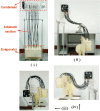Investigations of Li-Ion Battery Thermal Management Systems Based on Heat Pipes: A Review
- PMID: 38222571
- PMCID: PMC10785069
- DOI: 10.1021/acsomega.3c08056
Investigations of Li-Ion Battery Thermal Management Systems Based on Heat Pipes: A Review
Abstract
With increasing concerns about carbon emissions and the resulting climate impacts, Li-ion batteries have become one of the most attractive energy sources, especially in the transportation sector. For Li-ion batteries, an effective thermal management system is essential to ensure high-efficiency operation, avoid capacity degradation, and eliminate safety issues. Thermal management systems based on heat pipes can achieve excellent cooling performance in limited space and thus have been widely used for the temperature control of Li-ion batteries. In this paper, the thermal management systems of Li-ion batteries based on four types of heat pipes, i.e., flat single-channel heat pipes, oscillating heat pipes, flexible heat pipes, and microchannel heat pipes, are comprehensively reviewed based on the studies in the past 20 years. The effects of different influencing factors on the cooling performance and thermal runaway behavior of Li-ion batteries are thoroughly discussed in order to provide an in-depth understanding for researchers and engineers. It is concluded that for all types of thermal management systems based on heat pipes, water spray cooling could achieve better cooling performance than forced air cooling and water bath cooling, while its energy consumption is obviously smaller than forced air cooling. For thermal management systems based on oscillating heat pipes, improved heat transfer characteristics could be achieved by increasing the number of turns, using a relatively larger inner hydraulic diameter and using a length ratio between the evaporator and condenser higher than 1.0. Heat pipes fabricated by flexible materials suffer from permeation of noncondensable gases from ambient and leakage of working fluid. These issues could be partly resolved by adding thermal vias filled with metallic materials and covering the sealing part with indium coating or designing a multilayered structure with metallic materials in it. Moreover, the limitations and future trends of Li-ion battery thermal management systems based on heat pipes are presented. It is pointed out that the thermal runaway behavior and heating performance of battery thermal management systems based on heat pipes should be further elaborated. The analysis of this paper could provide valuable support for future investigations on Li-ion battery thermal management systems based on heat pipes; it could also guide the choice and design of Li-ion battery thermal management systems based on heat pipes in commercial use.
© 2023 The Authors. Published by American Chemical Society.
Conflict of interest statement
The authors declare no competing financial interest.
Figures












Similar articles
-
A critical review on renewable battery thermal management system using heat pipes.J Therm Anal Calorim. 2023 May 2:1-40. doi: 10.1007/s10973-023-12100-9. Online ahead of print. J Therm Anal Calorim. 2023. PMID: 37361725 Free PMC article. Review.
-
Li-ion battery cooling system integrates in nano-fluid environment.Appl Nanosci. 2017;7(1):25-29. doi: 10.1007/s13204-016-0539-6. Epub 2016 Oct 19. Appl Nanosci. 2017. PMID: 32215234 Free PMC article.
-
Optimization of Thermal and Structural Design in Lithium-Ion Batteries to Obtain Energy Efficient Battery Thermal Management System (BTMS): A Critical Review.Arch Comput Methods Eng. 2022;29(1):129-194. doi: 10.1007/s11831-021-09571-0. Epub 2021 Apr 26. Arch Comput Methods Eng. 2022. PMID: 33935484 Free PMC article. Review.
-
Optimization and analysis of battery thermal management system structure based on flat heat pipes and biomimetic fins.Heliyon. 2024 Aug 3;10(15):e35387. doi: 10.1016/j.heliyon.2024.e35387. eCollection 2024 Aug 15. Heliyon. 2024. PMID: 39170270 Free PMC article.
-
Carbon and Graphene Coatings for the Thermal Management of Sustainable LMP Batteries for Automotive Applications.Materials (Basel). 2022 Nov 3;15(21):7744. doi: 10.3390/ma15217744. Materials (Basel). 2022. PMID: 36363335 Free PMC article.
Cited by
-
Application of Refrigerant Cooling in a Battery Thermal Management System under High Temperature Conditions: A Review.ACS Omega. 2024 Jun 5;9(24):25591-25609. doi: 10.1021/acsomega.4c02902. eCollection 2024 Jun 18. ACS Omega. 2024. PMID: 38911816 Free PMC article. Review.
References
-
- Lan X.; Tans P.; Thoning K. W.. Trends in globally-averaged CO2 determined from NOAA Global Monitoring Laboratory measurements; NOAA/GML, 2023-12. https://gml.noaa.gov/ccgg/trends/gl_data.html (accessed 12/24/2023).
-
- British Petroleum . Energy Outlook, https://www.bp.com/en/global/corporate/energy-economics/energy-outlook (accessed 12/24/2023).
-
- Duh Y. S.; Sun Y. J.; Lin X.; Zheng J. J.; Wang M. C.; Wang Y. J.; Lin X. Y.; Jiang X. Y.; Zheng Z. G.; Zheng S.; Yu G. Characterization on thermal runaway of commercial 18650 lithium-ion batteries used in electric vehicles: A review. Journal of Energy Storage 2021, 41, 10288810.1016/j.est.2021.102888. - DOI
-
- Chen J.; Manivanan M.; Duque J.; Kollmeyer P.; Panchal S.; Gross O.; Emadi A.. A convolutional neural network for estimation of lithium-ion battery state-of-health during constant current operation. 2023 IEEE Transportation Electrification Conference & Expo(ITEC), Detroit, United States, June 21–23, 2023.
-
- Abada S.; Marlair G.; Lecocq A.; Petit M.; Sauvant-Moynot V.; Huet F. Safety focused modeling of lithium-ion batteries: A review. J. Power Sources 2016, 306, 178–192. 10.1016/j.jpowsour.2015.11.100. - DOI
Publication types
LinkOut - more resources
Full Text Sources
Miscellaneous
